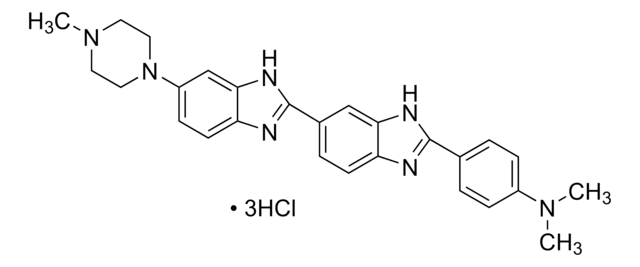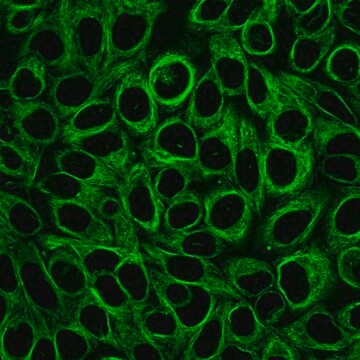94403
Hoechst 33258 -Lösung
1 mg/mL in H2O, ≥98.0% (HPLC)
Synonym(e):
Bisbenzimid H 33258 -Lösung
About This Item
Empfohlene Produkte
Qualitätsniveau
Assay
≥98.0% (HPLC)
Form
liquid
Konzentration
1 mg/mL in H2O
Löslichkeit
DMF: soluble
H2O: soluble
Fluoreszenz
λex 355 nm; λem 465 nm in TE buffer; DNA
Lagertemp.
2-8°C
SMILES String
Cl.Cl.Cl.CN1CCN(CC1)c2ccc3[nH]c(nc3c2)-c4ccc5nc([nH]c5c4)-c6ccc(O)cc6
InChI
1S/C25H24N6O.3ClH/c1-30-10-12-31(13-11-30)18-5-9-21-23(15-18)29-25(27-21)17-4-8-20-22(14-17)28-24(26-20)16-2-6-19(32)7-3-16;;;/h2-9,14-15,32H,10-13H2,1H3,(H,26,28)(H,27,29);3*1H
InChIKey
SMNPLAKEGAEPJD-UHFFFAOYSA-N
Allgemeine Beschreibung
Anwendung
Lagerklassenschlüssel
10 - Combustible liquids
Flammpunkt (°F)
Not applicable
Flammpunkt (°C)
Not applicable
Analysenzertifikate (COA)
Suchen Sie nach Analysenzertifikate (COA), indem Sie die Lot-/Chargennummer des Produkts eingeben. Lot- und Chargennummern sind auf dem Produktetikett hinter den Wörtern ‘Lot’ oder ‘Batch’ (Lot oder Charge) zu finden.
Besitzen Sie dieses Produkt bereits?
In der Dokumentenbibliothek finden Sie die Dokumentation zu den Produkten, die Sie kürzlich erworben haben.
Kunden haben sich ebenfalls angesehen
Unser Team von Wissenschaftlern verfügt über Erfahrung in allen Forschungsbereichen einschließlich Life Science, Materialwissenschaften, chemischer Synthese, Chromatographie, Analytik und vielen mehr..
Setzen Sie sich mit dem technischen Dienst in Verbindung.









